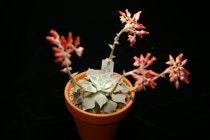
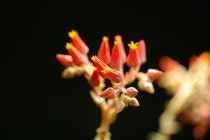
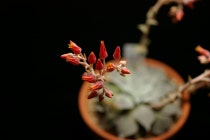
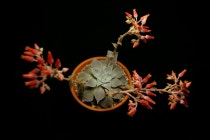
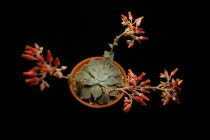
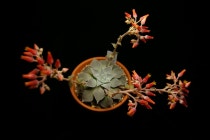
저희 집에도 사이모사가 3 종류 있습니다. 그 중 이름이 가장 확실한 녀석이 이 녀석이랍니다.
참고로 라틴어 pumila는 "난장이"라는 뜻이라고 합니다.
사이모사는 파리노사와 같이 바닷가에 사는 품종이 아니라 내륙 지역에 분포한다고 합니다.
해발 1,000피트에서 5,000피트 정도의 낮은 산에 분포하며 낮은 기온에서도 살아남을 수 있어서 약간 얼더라도 괜찮다고 하네요.
라틴어 cymosa는 "Cyme(취산화서)"에서 유래된 말입니다.
저도 뜻을 몰라 찾아봈습니다. 아래 취산화서에 관련된 내용을 보시고, 위에 올려진 꽃 사진을
보시면 잘 이해되리라 생각합니다.^^
취산화서 (聚散花序, cyme)
꽃차례의 끝에 달린 꽃 밑에서 한 쌍의 꽃자루가 나와 각각 그 끝에 꽃이 한 송이씩 달리고, 바로 그 꽃 밑에서 또 각각 한 쌍씩의 작은 꽃자루가 나와 그 끝에 꽃이 한 송이씩 달리는 꽃차례를 말합니다. 처음의 중앙에 있는 꽃이 먼저 핀 다음 주위의 꽃들이 피어 납니다.
ex) 작살나무, 백당나무
CYMOSA (Lemaire, 1858; B&R, 1903) Range: This is a Calif. inland species with no forms near the seashore. It is a species of the low mountains and foothills usually between 1000 & 5000 ft. elevation, and it can usually survive light freezes. In its various forms it is found over much of the Coastal range and just into the western foothills of the Sierra Nevada mountain range. It loves to grow on cliffs and slopes, often vertical among grasses and other plants, often above streams and rivers, often in semi-shade. Chromosome count n=17 (this seems to be the same for all ssp. also). The plants are variable from site to site. For this species a complex of many subspecies is recognized and is listed below, each with a “+” sign. The leaves are usually light green, but can be a bit frosted and with color blushes. The rosettes can be quite attractive, usually single. The flowers are usually on long spikes or sometimes as cymes as the species name indicates, and are usually in shades of pale yellow. More details p. 334 to 336 of Oct. 1987 Madroño, and p. 67 in the book of Thomson, or p. 722 in Munz Calif. Flora. See small line-drawing on p. 529 of Jepson.
=*D. cymosa (Lemaire, 1858; Britton & Rose, 1903), current.
=E. cymosa (Lemaire, 1858), obs.
=C. cymosa (Baker, 1869), obs.
=C. laxa var. cymosa (Jepson, 1925), obs.
=E. laxa var. cymosa (Jepson, 1936), obs.
+ssp. costfolia, (Bartel & Shevock, 1990), current.
=D. costafolia (Thomson, 1993), obs. [“costafolia” means “ribbed-leafed”; range foothills in Tulare County, Calif. 20 miles east of Porterville; rare & endangered, has bright yellow flowers in May, common name “Pierpont Springs Live forever”].
+ssp crebrifolia (Nakai, & Verity, 1988), current. [“crebrifolia” means (?) but possibly “many leafed”; range in Los Angeles County in San Gabriel Mts. at 1200 ft. closely related to ssp. pumila; uncommon today, p. 66 in Thomson book, common name “San Gabriel River Dudleya”].
=D. crebrifolia (Thomson, 1993), obs.
+ssp. cymosa (B&R, 1903), current. [This is the “type-species”. Range: Northern & cent. Calif. and maybe a bit into s. cent. Oregon, most common in w. foothills of Sierra Nevada mts. east of Sacramento, even in Folsom; flowers usually orange, but can extend to yellows & reds, grows on vertical cliffs, blooms by elevation from April to June].
=C. nevadensis (Watson, 1876), obs. [“nevadensis” refers to the Sierra Nevada Mts. of Calif. and not state of Nevada.].
=D. nevadensis (B&R, 1903), obs.
=E. nevadensis (Nelson & Macbride, 1913), obs.
=C. laxa var. nevadensis (Jepson, 1936), obs.
=C. purpusii (Schumann, 1896), obs. [“purpusii” refers to Carl & Joseph Purpus, plant hunters of Germany & the USA].
=E. purpusii (Schumann, 1896), obs.
=D. purpusii (B&R, 1903), obs.
=C. plattiana (Jepson, 1901), obs.
=D. plattiana (B&R, 1903), obs.
=E. plattiana (Nelson & Macbride, 1913), obs.
=D. angustiflora (Rose, 1913), obs. [means “narrow flower”].
=C. angustiflora (Fedde, 1904), obs.
=E. angustiflora (Berger, 1930), obs.
=D. gigantea (Rose, 1903), obs. [means “giant”].
=C. gigantea (Fedde, 1904), obs.
=D. cymosa ssp. gigantea (Moran, 1957), obs.
=D. sheldonii (Rose, 1903), obs.
=C. sheldonii (Fedde, 1904), obs.
=E. sheldonii (Berger, 1930), obs.
=E. amadorana (Berger, 1930), obs. [refers to Amador County].
=E. lanceolata var. incerta (Jepson, 1936), obs. [“incerta” means “uncertain”!].
+ssp. marcescens (Moran, 1957), current. [“marcescens” means “withering”; range: Santa Monica mts. at 150 to 500 m in 2 small ranges just NW of Los Angeles: one is coastal w. of Malibu & the other is inland in Little Sycamore Canyon].
=D. marcescens (Thomson, 1993), obs.
+ssp. ovatifolia (Moran, 1957), current. [means “oval leafed”; range: Santa Monica mts. at 150 to 500 m alt. in 2 small ranges: first 4 miles w. of Santa Monica for 2 miles along coast to 6 miles inland in Topanga Canyon; other in Santiago Canyon of Santa Ana mts. of Orange county 6 miles n. to s. & 2 miles e to w growing on north facing mossy canyon walls. ].
=D. ovatifolia (Britton, 1903), obs.
=C. ovatifolia (Fedde, 1904), obs.
=E. ovatifolia (Berger, 1930), obs.
=D. cymosa ssp. agourensis (Nakai, 1988), obs.
=D. agourensis (Thomson, 1993), obs.
+ssp. paniculata (Nakai, 1988), current. [means “panicled” fl. cluster. Range: Coastal range of mts. near San Francisco at 30 to 1200 m from Monterey bay to 20 miles inland in the mts. on canyon walls & cliffs].
=C. caespitosa var. paniculata (Jepson, 1901), obs.
=D. paniculata (B&R, 1903), obs.
=C. paniculata (Fedde, 1904), obs.
=C. laxa var. paniculata (Jepson, 1925), obs.
=D. humilis (Rose, 1903), obs.
=E. jepsonii (Nelson & Macbride, 1913), obs.
=E. diaboli (Berger, 1930), obs. [this name refers to Mt. Diablo located in this area].
+ssp. pumila (Nakai, 1988), current. [means “dwarf”; range: S. Coastal & w. transverse range of Calif. at 50 to 2600 m. from Monterey county s. to San Gabriel & San Bernardino Mts. at high altitude].
=D. pumila (Rose, 1903), obs.
=C. pumila (Fedde, 1904), obs.
=D. bernardiana (Britton, 1903), obs.
=C. bernardiana (Fedde, 1904), obs.
=E. bernardiana (Berger, 1930), obs.
=D. goldmanii (Rose, 1903), obs.
=E. goldmanii (Berger, 1930), obs.
=C. roseana (Fedde, 1904), obs.
=E. parva (Berger, 1930), obs.